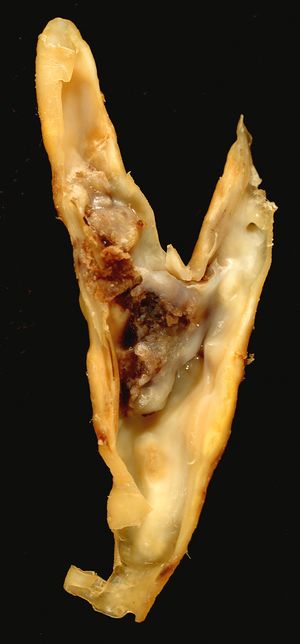عصيدة (طب)
| عصيدة (طب) | |
|---|---|
 | |
| لويح تصلب شرايين من عينة carotid endarterectomy. وهي تبين التفرع الثنائي of the common إلى internal وexternal carotid arteries. | |
| التبويب والمصادر الخارجية | |
| التخصص | طب القلب |
| ICD-10 | I70.9 |
| ICD-9-CM | 440 |
| DiseasesDB | 1039 |
| Patient UK | فشل عرض الخاصية P1461: لم يتم العثور على الخاصية P1461. عصيدة (طب) |
| MeSH | C14.907.137.126.307 |
في علم الأمراض، العصيدة atheroma (وجمعها: عصائد atheromata) هي تراكم وانتفاخ (-oma) في جدران الشرايين المبنية من خلايا (معظمها خلايا macrophage)، أو ركام خلايا، يحتوي دهون (كولسترول وأحماض دهنية)، وكالسيوم وكم متغير من نسيج رابط ليفي. وفي سياق مواضيع القلب أو الشرايين، فإن العصيدة يشيع الإشارة إليها بإسم لويحات عصيدية atheromatous plaques. وهي حالة غير صحية، ولكنها توجد في معظم البشر.[بحاجة لمصدر]
These anatomic lesions usually begin in some children younger than age 1 year and all children older than age 10 regardless of geography, race, sex or environment. Veins do not develop atheromata, unless surgically moved to function as an artery, as in bypass surgery. The accumulation (swelling) is always between the endothelium lining and the smooth muscle wall central region (media) of the arterial tube, see IMT. While the early stages, based on gross appearance, have traditionally been termed fatty streaks by pathologists, they are not composed of fat cells, i.e. adipose cells, but of accumulations of white blood cells, especially macrophages that have taken up oxidized low-density lipoprotein (LDL). After they accumulate large amounts of cytoplasmic membranes (with associated high cholesterol content) they are called foam cells. When foam cells die, their contents are released, which attracts more macrophages and creates an extracellular lipid core near the center to inner surface of each atherosclerotic plaque. Conversely, the outer, older portions of the plaque become more calcific, less metabolically active and more physically stiff over time.
وجمعاً، فإن عملية تطور العصيدة في شخص ما تسمى تكون التصلب atherogenesis والنتيجة الكلية لعملية المرض تسمى تصلب الشرايين atherosclerosis.
. . . . . . . . . . . . . . . . . . . . . . . . . . . . . . . . . . . . . . . . . . . . . . . . . . . . . . . . . . . . . . . . . . . . . . . . . . . . . . . . . . . . . . . . . . . . . . . . . . . . . . . . . . . . . . . . . . . . . . . . . . . . . . . . . . . . . . . . . . . . . . . . . . . . . . . . . . . . . . . . . . . . . . . .
انظر أيضاً
- Angiogram
- ApoA-1 Milano
- Atherosclerosis
- Atherothrombosis
- Coronary circulation
- Coronary catheterization
- EBT
- Hemorheologic-Hemodynamic Theory of Atherosclerosis
- Lipoprotein
- LDL, HDL, IDL and VLDL
الهامش
المصادر
- Glagov S, Weisenberg E, Zarins CK, Stankunavicius R, Kolettis GJ (1987). "Compensatory enlargement of human atherosclerotic coronary arteries". N Engl J Med. 316 (22): 1371–5. PMID 3574413.
{{cite journal}}: Unknown parameter|month=ignored (help)CS1 maint: multiple names: authors list (link)
- Vos E, Rose CP (2005). "Questioning the benefits of statins". CMAJ. 173 (10): 1207, author reply 1210. doi:10.1503/cmaj.1050120. PMC 1277053. PMID 16275976.
{{cite journal}}: Unknown parameter|month=ignored (help)
